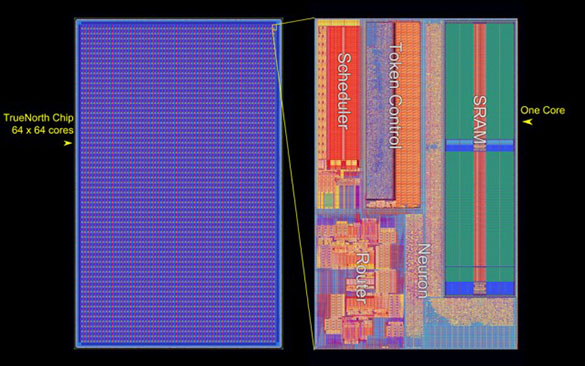IBM’s 4096-Core SyNAPSE Processor Thinks and Processes Like A Human
Emulating the behavior of a human brain is one of the toughest challenges scientists and engineers have ever faced. A major reason for that is the sheer amount of computational power our brains possess. Feel dumb because you turned the coffee machine on and forgot to add the water? Don't fret - your brain is still an amazingly complex thing.
Today's computers, and especially supercomputers, offer an incredible level of performance, but they operate in a far stricter way than our brains, with its many neurons, do. They can, and have emulated the human brain to a great extent in the past, but it's long been argued that truer emulation would reap greater rewards. Quite simply, a computer-backed human brain could accomplish some breakthrough things.

IBM's TrueNorth Chip
For that to be ultimately possible, though, a special cognitive chip needs to be designed - and as this post would suggest, just such a chip has been produced as part of a collaboration between IBM Research and Cornell University. It's called SyNAPSE, and its specs are downright impressive.
Built on a 28nm process, a SyNAPSE chip contains 5.4 billion transistors. For comparison's sake, a 15-core Intel Xeon processor has 4.31 billion transistors. Within those 5.4 billion transistors are 256 million programmable synapses, boasting total performance of 46 billion synaptic operations-per-second.
If none of that strikes you as impressive, picture this: The chip operates at 70mW. That's 0.07W. At 155W, the above-mentioned 15-core Intel Xeon draws about 2,200x more power. For a chip that's meant to emulate a brain, IBM is sure going to blow a lot of them with these kinds of specs.
In a graphic posted to IBM's Flickr page, we can see the incredible advances that have been made in only a couple of years. In 2011, a chip like this had a mere 256 programmable neurons (vs. 1 million), 262K programmable synapses (vs. 256 million), and just a single neurosynaptic core (vs. 4,096).
Ultimately, IBM hopes to eventually create a chip that would make the current one look like child's play - as hard as that is to imagine. Its target? 10 billion neurons, and 100 trillion synapses.

If there's a problem with IBM's TrueNorth chip, it's that software needs to be written for it. As Ars Technica notes, part of this problem has been remedied by integrating TrueNorth into an existing neural software package, called Compass. As Compass has a rich software library available, the fact that TrueNorth can essentially be slipstreamed in is a great thing.
Truly impressive stuff here. We're quickly reaching a point where microprocessors are as awe-inspiring as outer space.

